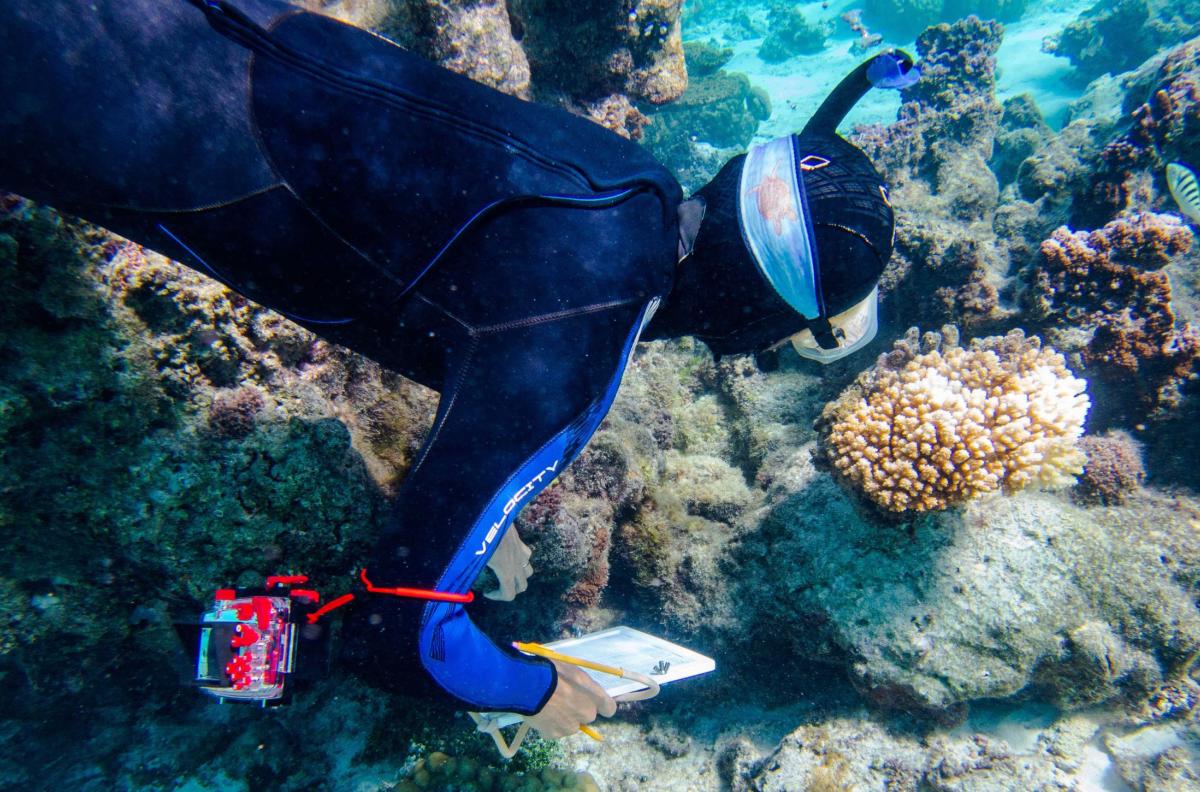
Professor Deron Burkepile observes coral in the process of bleaching in the reefs around Moorea. Photo Credit: Jeff Liang
UC Santa Barbara scientists investigated how two kinds of disturbances might affect coral reefs. They found that coral struggles more to recover from bleaching than from storms, even when mortality was similar between the two events. The skeletons left behind after bleaching appear to offer protection to algae, which then edge out the slow-growing coral. The study, led by doctoral student Kai Kopecky, appears in the journal Ecology.
Most shallow-water corals host symbiotic algae that provide the animals with food in exchange for a safe home and nutrients. But extreme conditions can throw this arrangement out of alignment, causing the coral to expel their partners in a process known as bleaching, which is often fatal.
Researchers at UC Santa Barbara have studied coral and their reef ecosystems around the island of Moorea, French Polynesia since the late 1980s. Kopecky’s second visit to the island coincided with a major bleaching event.
Unfortunately a different pattern began to emerge this time. Seaweed, a major competitor with coral for space on the reef, began colonizing the bleached skeletons. Kopecky wondered if the skeletons’ presence was setting the reef on a pathway toward a more algae-dominated state.
Previous work at Moorea showed that tropical reefs can host either coral- or seaweed-dominated communities. These distinct states are resilient to small disturbances, but a large shock can flip the ecosystem from one to the other in a process called hysteresis. Once this happens, the reef won’t revert to its previous state even if the conditions do. The system has found a new equilibrium.
Kopecky developed a mathematical model to compare reef dynamics after a bleaching event — which leaves skeletons in place — and after a storm — which scours the reef bare.
The results were telling. “Just the fact that those skeletons are left on the reef results in these fundamentally different patterns of recovery,” Kopecky said.
Coral skeletons seem to protect young algae from herbivores that would otherwise keep it in check. The animals can’t get in all the crevices, so the algae gains a foothold from which to spread.
This protection doesn’t appear to provide the same benefits to young coral. The authors suspect that coral don’t face as much pressure from predators as algae do. What’s more, algae can quickly outgrow coral when given the chance. “Coral is literally laying down rock, while the algae are mostly just fast-growing, soft, leafy material,” said senior author Holly Moeller, an assistant professor of ecology, evolution and marine biology.
Reef buildup is a slow process, with coral death usually balanced by recruitment. New growth incorporates dead skeletons into the larger reef structure. But bleaching kills a lot of coral all at once — especially the oldest and youngest — and the skeletons eventually become brittle through erosion. It’s not a strong foundation for young coral to build their lives upon.
If dead skeletons hinder coral recovery, why not simply remove them?
However, coral skeletons provide many benefits. They form habitat for sundry kinds of animals and some evidence suggests that the structural complexity of a reef correlates with faster coral recovery.
“Kai’s study is a classic example of the value of mathematical models in ecology,” Moeller said. Coral can live for hundreds of years, and reef recovery can take decades. “That’s just not an experiment that you can do realistically.
“But if you have a model,” she continued, “and you trust the way you set that model up because you’ve done other experiments, then you can make these projections decades into the future.